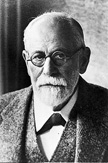 Sigmund Freud was born on May 6, 1856, in Freiberg, Moravia (now Pribor, in the Czech Republic) as the third son of Jakob Freud, a Jewish wool merchant, and the first child of his second wife, Amalie Nathansohn. In 1859, the Freud family moved to Leipzig, in Germany, but a year after, they settled in Vienna, the city where Sigmund Freud was to live for the next 78 years.
Sigmund Freud was born on May 6, 1856, in Freiberg, Moravia (now Pribor, in the Czech Republic) as the third son of Jakob Freud, a Jewish wool merchant, and the first child of his second wife, Amalie Nathansohn. In 1859, the Freud family moved to Leipzig, in Germany, but a year after, they settled in Vienna, the city where Sigmund Freud was to live for the next 78 years.
Freud graduated from the Sperl Gymnasium in 1873 and turned to medicine as a career studying at the University of Vienna. There he was in contact with Ernst von Brucke (1819-1892), a leading physiologist of his time. In 1882, Freud entered the General Hospital in Vienna as a clinical assistant and three years later was appointed lecturer in neuropathology.
Freud continued his studies of neuropathology at the Salpetriere clinic in Paris in 1885 under the guidance of Jean-Martin Charcot (1825-1893). Freud’s acquaintance with Charcot’s theories and practice had a significant influence on his career helping him to concentrate his research on the mind as source of neurotic conditions rather than the brain. A short time after his return from Paris, Freud married Martha Bernays, a descendant of a famous Jewish family whose ancestors included Heinrich Heine and a chief rabbi of Hamburg.
Having settled at 19 Bergasse in Vienna, his home for more than fifty years, Freud began his collaboration with Josef Breuer (1842-1925). One of Breuer’s patients, Bertha Pappenheim, or Anna O., as she is known in the psychoanalytical literature, was later instrumental in developing Freud’s method of free association.
Freud’s fame came with the publication in 1899 of The Interpretation of Dreams who proved to turn into one of the most influential works not only in the field of psychoanalysis, but also in many other scientific, cultural and artistic disciplines. His prolific career is illustrated by a long list of publications, among them the best known are The Psychopathology of Everyday Life, 1904; Jokes and Their Relation to the Unconscious, 1905; Three Essays on the Theory of Sexuality, 1905; The Origin and Development of Psychoanalysis, 1910; Beyond the Pleasure Principle, 1920; The Ego and the Id, 1923. However, Freud also disclosed a keen interest in the field of sociology and social psychology, as proven by a number of significant essays: Totem und Tabu, 1913; Group Psychology and the Analysis of the Ego, 1921; The Future of an Illusion, 1927; Civilization and Its Discontents, 1930; Moses and Monotheism, 1938.
Freud was not a practicing Jew, but he never rejected his religion. In an interview with George Sylvester Viereck in 1926 and published a year later, Freud clearly stated his identity: “My language is German. My culture, my attainments are German. I considered myself German intellectually, until I noticed the growth of anti-Semitic prejudice in Germany and German Austria. Since that time I prefer to call myself a Jew.”
Freud encountered many anti-Semitic incidents during his lifetime, but the worst occurred after the Nazis’ seizure of power in Germany. Freud’s books were denounced as “expressions of Jewish science” and were publicly burned as early as 1933. When Austria was annexed by Nazi Germany in 1938, Freud was forced to flee the country and with the help of friends settled in England. He died of cancer on September 23, 1939, three weeks after the outbreak of the World War II.